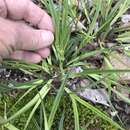Comprehensive Description
provided by North American Flora
Carex abscondita Mackenzie, Bull. Torrey Club 37: 244. 1910.
Carex ptychocarpa Steud. Syn. Cyp. 234. 1855. (Type from New Orleans, Louisiana.) Not C. ptychocarpa Link, 1799.
Densely cespitose, the rootstocks short, the culms mostly central, low, erect but weak, 0.5-2 dm. high, usually much hidden by and from little exceeding to much shorter than the strongly developed leaves, hispidulous, triangular-compressed, light-brownish-tinged at base, the sterile shoots elongate, conspicuous; foliage light-green or somewhat glaueous, the blades of the lower leaves and those of the sterile culms 1-3 dm. long, 4-9 mm. wide, flat, thin, from erect to recurving-spreading, the midnerve strongly developed on the lower and the two midlateral nerves on the upper surface, acute or short-acuminate, roughened on the margins and hispidulous on the veins towards the apex, the upper blades shorter, the sheaths very thin and white-hyaline ventrally, the ligule long and conspicuous; staminate spike largely hidden, narrowly linear, sessile or nearly so, about the length of the upper pistillate one, 4-9 mm. long, 0.5-1.5 mm. wide, the scales obovate, closely appressed, obtusish to acuminate, greenishwhite-hyaline, with 3-nerved green center, yellowish-brown-tinged and red-dotted; pistillate spikes 1-4, linear or linear-oblong, often staminate at apex, the lowest scale not empty, 0.51.5 cm. long, 2.5-3.5 mm. wide, the lower widely separated, the lowest nearly basal on very slender smooth peduncles 1-8 cm. long, erect, ascending, or drooping, the upper on shortexserted erect peduncles or not exsert-peduncled, contiguous with the staminate spike, alternately and rather loosely 3-10-flowered, the perigynia erect-appressed ; upper bracts shortsheathing, that of the second pistillate spike much developed, subspathaceous, 3.5 cm. long and exceeding the culm and uppermost bract, the sheaths green, the edges entire, hispidulous; scales small, ovate-triangular, the margins white-hyaline, the center green, 3-nerved, slightly brownish-yellow-tinged, the lower cuspidate, the upper acute or obtuse, narrower and much shorter than the perigynia; perigynia obovoid, sharply triangular, not at all inflated, hispidulous, membranaceous, light-olive or yellowish-green, 2.5-3.5 mm. long, 1.5 mm. wide, finely many-nerved, substipitate, short-tapering at base, tapering at apex or contracted into a very short erect or slightly bent beak or point, with entire hyaline orifice; achenes broadly obovoid, sharply triangular with deeply concave sides, closely filling the perigynium, 2-2.5 mm. long, 1.5 mm. wide, brownish, reticulate, substipitate, short-apiculate, jointed with the very short slender style; stigmas three, short, 1.5 mm. long, slender, reddish-brown.
Type locality (of C. ptychocarpa, on which C. abscondita is based): New Orleans, Louisiana (Drummond 424).
Distribution: Dry woodlands (usually beech), Florida and Louisiana, and northward mostly on the coastal plain to Massachusetts, and in the interior to Indiana. (Specimens examined from Massachusetts, Connecticut, New York (Long Island), New Jersey, Pennsylvania, Delaware, Maryland, District of Columbia, Virginia, North Carolina, South Carolina, Georgia, Alabama, Florida, Louisiana, Missouri, Indiana.)
- bibliographic citation
- Kenneth Kent Mackenzie. 1935. (POALES); CYPERACEAE; CARICEAE. North American flora. vol 18(5). New York Botanical Garden, New York, NY
Comprehensive Description
provided by North American Flora
Carex magnifolia Mackenzie; Small, Fl. SE. U. S ed 2. 1325. 1913.
Carex digitalis var. glauca Chapm. Fl. S. U. S. 541. 1860. (Type from Florida.) Carex ptychocarpa var. macrophylla L. H. Bailey, Mem. Torrey Club 1: 48. 1889. (Based on C. digitalis var. glauca Chapm.)
In large clumps, from short creeping rootstocks, the culms 1-2 dm. high, phyllopodic, mostly central, very slender, sharply triangular, smooth, 2-3 times exceeded by the very long basal leaves, light-brownish-tinged at base, the sterile shoots elongate, conspicuous; leaves usually 4—7 to a culm, clustered near the base, the blades flat, thin, strongly glaucous, 1.5-3.5 dm. long, 5-8 mm. wide, hispidulous on the veins towards the acute apex, the midnerve prominent on the lower surface, and the two mid-lateral nerves on the upper, the sheaths thin ventrally, the ligule long and conspicuous; staminate spike sessile or nearly so, narrowly linear, about length of upper pistillate spike, about 1 cm. long, 1.5 mm. wide, the scales closely appressed, oblong-obovate, obtuse, white-hyaline with greenish 3-nerved center, somewhat reddishbrown-tinged; pistillate spikes usually 3, erect, the lowest widely separate, nearly basal, and slenderly long-peduncled, the upper two and the staminate closely approximate, sessile or shortpeduncled, often exceeding the staminate, the spikes 8-20 mm. long, about 5 mm. wide, rather loosely 5-14-flowered, the perigynia ascending in few rows; lowest bracts of the nonbasal spikes leaf-like, subspathaceous, several times exceeding the culm, short-sheathing, the sheaths with entire edges, the blade 4—7 mm. wide, the uppermost much smaller; scales very broadly ovate, small, spreading, 2 mm. long, obtuse or acutish, whitish-hyaline, with colored 3-nerved center, narrower than and about one fourth the length of the perigynia; perigynia broadly fusiform, not inflated, sharply triangular, 4—4.5 mm. long, the sides nearly 2 mm. wide, finely many-nerved, hispidulous, membranaceous, light-olive or yellowish-green, broadly stipitate, contracted into the base and into a straight or slightly oblique beak 1 mm. long, the orifice oblique, hyaline, entire ; achenes obovoid, triangular with concave sides, filling perigynium, 3 mm. long, nearly 2 mm. wide, substipitate, short-apiculate, jointed with the very short slender style; stigmas three, slender, short, 1.5 mm. long, reddish-brown.
Type locality (of C. digitalis var. glauca, on which C. magnifolia is based): Shaded swamps, middle Florida (Chapman, 1842).
Distribution: Shaded swamps, middle Florida. (Specimens examined from middle Florida.)
- bibliographic citation
- Kenneth Kent Mackenzie. 1935. (POALES); CYPERACEAE; CARICEAE. North American flora. vol 18(5). New York Botanical Garden, New York, NY

